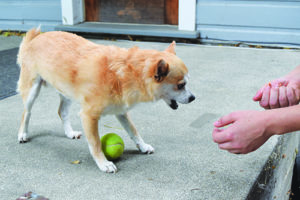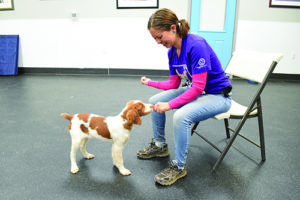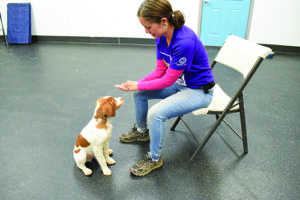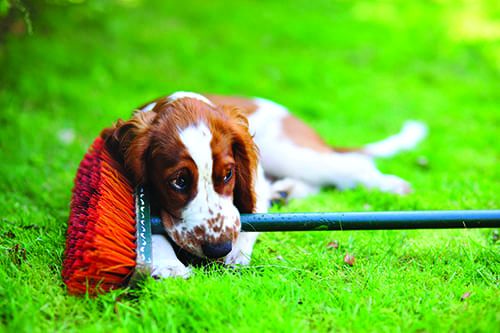First, you have to understand: It is perfectly normal for puppies to explore the world with their mouths. Usually, it’s not a big deal and no harm comes from pups learning about their environment in this manner. They will nibble a bit of grass or a leaf, pick up a stick, or grab a stray sock. Most of the time, puppies will pick things up, chew a little, spit them out, and go on their way.
But on occasion, pups can get themselves into serious trouble by eating things they shouldn’t – mushrooms or marijuana, plastic or electronics, socks or rocks. The following steps can help protect your pups and teach them not to chomp on everything in sight while they are growing up.
PREVENTION: THE FIRST LINE OF DEFENSE
Puppy-proofing your house should be undertaken before you bring a puppy home. Shoes, socks, kid’s toys, even the TV remote should be picked up and put out of reach. Tidying up makes a big difference. When you can’t supervise your pup, keep her in a puppy safe area such as behind a baby gate in the kitchen, in an exercise pen, or in a crate.
Check your yard for poisonous plants, mushrooms, colored mulches, and other potentially toxic things. Temporary fencing around plants can protect your pup until she’s learned better judgement and restraint. On walks and when exploring the neighborhood, pay attention to what’s on the ground. Scan the environment before you let your pup sniff and explore. Keep her on leash in any area that you haven’t visually swept for hazards.
Don’t worry, these measures won’t last forever. Most puppies do outgrow the “eat everything” stage, but until they do, keep them safe.
CHANNEL THEIR CHEWING
Putting things in their mouths is almost a compulsion for some pups. Puppies go through various stages with this, depending on their stage of teething. Channeling their desire to sniff, explore, and chew safely will make it a little less likely that they will do so at other times.
Start by giving your pup lots of interesting things to chew. Rotate chew items so your pup doesn’t get bored with the same items day after day. Make sure you provide toys of many different textures: hard, chewy, squishy, woolly, leathery, and so on. Stuff Kong-type toys with wet food that has to be licked and chewed out of crevices, and try other treat-dispensing toys. When puppies have lots of chewing options, they are less likely to hunt for new or weird things to chew.
You can also give your puppy safe opportunities to use her nose to find toys and food. “Find it” games with toys or treats can channel a puppy’s natural need to seek out interesting things. For example, in a safe area of your home or garden, hide a few tasty treats and let your pup search for them. Join her on the search. Share her joy at finding cool stuff!

Another great tool is a “snuffle mat.” This is a specially designed toy that you can hide kibble or treats in. Your pup will have a blast finding her food and it will help satisfy her natural desire to search for interesting things.
DON’T PANIC
If, every time your puppy picks up something in her mouth, you rush in, grab her, and wrestle whatever it was out of her mouth, your pup will quickly learn to do her best to keep you from seeing her pick stuff up or taking things away. She’ll likely learn to run or or hide when she finds a “treasure” that she wants to investigate at her leisure – but some pups will try to rapidly swallow items so that you can’t take them away.
Instead of rushing in, evaluate the situation. Did your puppy just munch a few blades of grass? Did he pick up a stick and chew it for a moment? These types of explorations are not usually dangerous and taking them in stride will help when you do need to take something away.
TRAIN FOR WHEN YOUR PUP NEEDS TO REFRAIN
Here are a few exercises everyone can practice with their pups and dogs. They will pay off big time for those moments when, for her own safety, your pup really needs to refrain from chewing or swallowing something.
- Drop it. This is a “spit that thing out of your mouth” behavior. The steps to teach it are pretty easy, but they take some practice.
Start by giving your dog something that she likes to put in her mouth – a toy, a chewie, or something like a food toy. Say, “Drop it!” and then offer her something better than what she already has – say, some succulent, fresh-roasted chicken. When she drops the item to eat the chicken, praise her like crazy and reward her super generously – for example, with four or five pieces of chicken in a row. Then let her have whatever she had in her mouth again.
Start with easier stuff, and graduate to having her drop more enticing things. Always reward generously with something better than what she has and, when practicing, always let your dog regain the item she dropped.
Practice this every day with several items for two to three weeks, then at least once a week thereafter. I also reinforce the “Drop it” behavior whenever I play fetch with my dog. Before I will throw a ball for her to chase, I ask her to drop the ball that she has.
- Trade. This is similar to “Drop it,” but it can be for things that may or may not be in the dog’s mouth; also, it involves an extra step of removing the item for a moment.
Ask your dog to drop an item and reward her generously when she does. Then say, “Trade!” and pick up the item. Reward her again, generously, with four or five pieces of a high-value treat. Then give the item back to her. When training, always return the item to your dog! You want her to learn that she can give you something without losing it. Also, every now and then, you can do a trade with your dog where you take an item she has, you reward her (generously!), and then you give her a different, more valuable item instead of giving the first item back.
As with the “Drop,” practice this with several items a day, starting with easy items. Progress slowly to more challenging trades, and keep up the daily practice for several weeks. Then keep it sharp by practicing at least once a week.
- Doggy Zen (“If you leave the treat, you will get the treat.”) This helps dogs learn impulse-control around things that they are interested in getting. This entire exercise is done without giving a cue.
1. Start with several treats in your closed fist. Present your fist to your dog, palm side up, off to the side, and at least two feet away from your dog, as seen below. Immediately start feeding treats to her from your other hand. Feed about 10 treats in a row, at a rate of about one per second. Praise your pup’s brilliance!

Do this several times or until you can present the closed treat-filled fist to your dog and she starts looking to you for her rapid rewards.
2. Present your fist full of treats to your pup the same way – palm side up, off to the side, about two feet from your pup. Your puppy should look to you for those rapid treats from the other hand. Before giving her the rapid treats, open your fist to a flat hand, so that the treats are now in view; then immediately start rapid treating from the other hand – once again, 10 treats in a row, at a rate of about one per second. Do this step until your pup easily looks to you when you bring out your fist full of treats and open your hand so the treats are easily accessible.
If at any point your pup goes for the treats in your open hand, just calmly close your hand back into a fist. Hold your fist perfectly still. Don’t pull it away. Don’t say “No!” or “Leave it!” Just wait patiently. When your pup backs away from your hand (they usually do this quickly because you have prepped them for it by doing Step 1 first), open your hand and try again. If your pup dives for the treats a second time, simple close your fist and go back to Step 1 for a little longer. Once your pup aces Step 2, continue to Step 3.

3. Now that your pup waits while you present an open hand of treats, you will feed her the treats from your open hand, one at a time, with your other hand. If your pup dives for the treats at any point, simply close your fist as above. If she does it a second time, go back to step 2. Soon your pup will back away and wait while you open your hand, and slowly feed her one treat at a time.
- The automatic leave it. There are two types of “leave its” that you will want to practice with your dog. One is the “automatic leave it” – this is when your dog leaves something interesting alone without you saying anything. The Doggy Zen exercise above will help prep your puppy for the automatic leave it. This exercise will pay off when your puppy encounters things on the ground that you don’t notice, as well as with counter surfing and dropped items in your kitchen.
Start with your pup on leash. Put an interesting item, such as a small container of kibble, on the ground out of your dog’s reach. Prevent your dog from reaching the container with the leash, but as soon as you put the container down, start rapidly delivering treats to your dog, one after another, with a high-value food. As with the Doggy Zen exercise, feed about 10 pieces of food at a rate of about one per second.
After a couple of repetitions of this, when you down put the container of kibble, your dog will quickly look at you, expecting those 10 pieces of chicken! Capture this disengagement by marking with the “click” of a clicker or a verbal signal such as the word “Yes!” and immediately reinforce with your rapid delivery of treats. Be sure to mark the second your dog’s head turns toward you.
Once your dog is easily and successfully turning away from the kibble, try this with more interesting foods, such as training treats or cheese.
When your dog is successfully turning away from food with no prompting from you, move the food to other surfaces, such as a coffee table or kitchen counters.
Continue practicing this for several days. Reward every time your dog ignores the food.
When your dog is a rock star at this exercise on leash, practice with your dog off leash – but set her up to succeeed, not to fail. If you attempt to have her turn away from a pile of roast chicken on her first off-leash trial, she might find it too tempting and dive for the food; if this happens, it will set you back. Gradual successes build reliability much faster than pushing your pup so quickly that she makes mistakes.
- Leave it (the cued behavior). For the quickest success, train the “automatic leave it” first. Then, once your pup is reliably refraining from the food you set down or drop as if by accident, it’s pretty simple to add a cue to the behavior. Simply say, “Leave it!” just before your pup is about to turn away from the food – and reward her generously when she does. She will quickly learn that when she hears those words, she should turn away from whatever interests her to get a fantastic reward.
REWARD GENEROUSLY
Reinforcing your pup consistently and generously when she resists putting something in her mouth or when she gives you something back will pay off big time! Your reinforcement should be anything that’s better or more valuable (in your dog’s opinion) than what she already has. In most cases, a super-duper, high-value food works well, but sometimes, giving multiple pieces of food, one after another, can make up for not being as good as what you are asking your dog to drop. And for some dogs, a game of tug or a chase of a ball will be an awesome reward! Every dog has his or her own opinion about what is valuable, so choose carefully for your dog.
Following the above guidelines and teaching these skills will help your pup get through the “put everything in their mouths” stage of life and give you impulse-control tools that will serve you and your pup for a lifetime!







Thank you!
Your feedback is excellent!
Thank you from Grand Turk in the British West Indies!
Angel
I have been training an IMPULSE CONTROL exercise very similar to your ZEN. It works very well for calming and returning your pup to focus and to keep them safe . Your explanations for “ the whys” of practicing this are most valuable for my class participants. May I use this verbiage in my classes giving credit to the author? Kerry Sheridan
Another great article! Such an informative post. Your blog always brings us vast treasure of knowledge! keep going with your great work!
I trained my dog like this when he was a puppy. It was essential as he was picking up stones on walks. It does work if you do the training properly.
I’m glad that you talked about dogs getting into serious trouble just by stuffing things into their mouths that they shouldn’t. My own pet almost choked on his toy after playing with it too much and he can’t seem to understand me when I kept on signaling him “NO”. Maybe I should consider dog obedience lessons in order to tame his behavior.